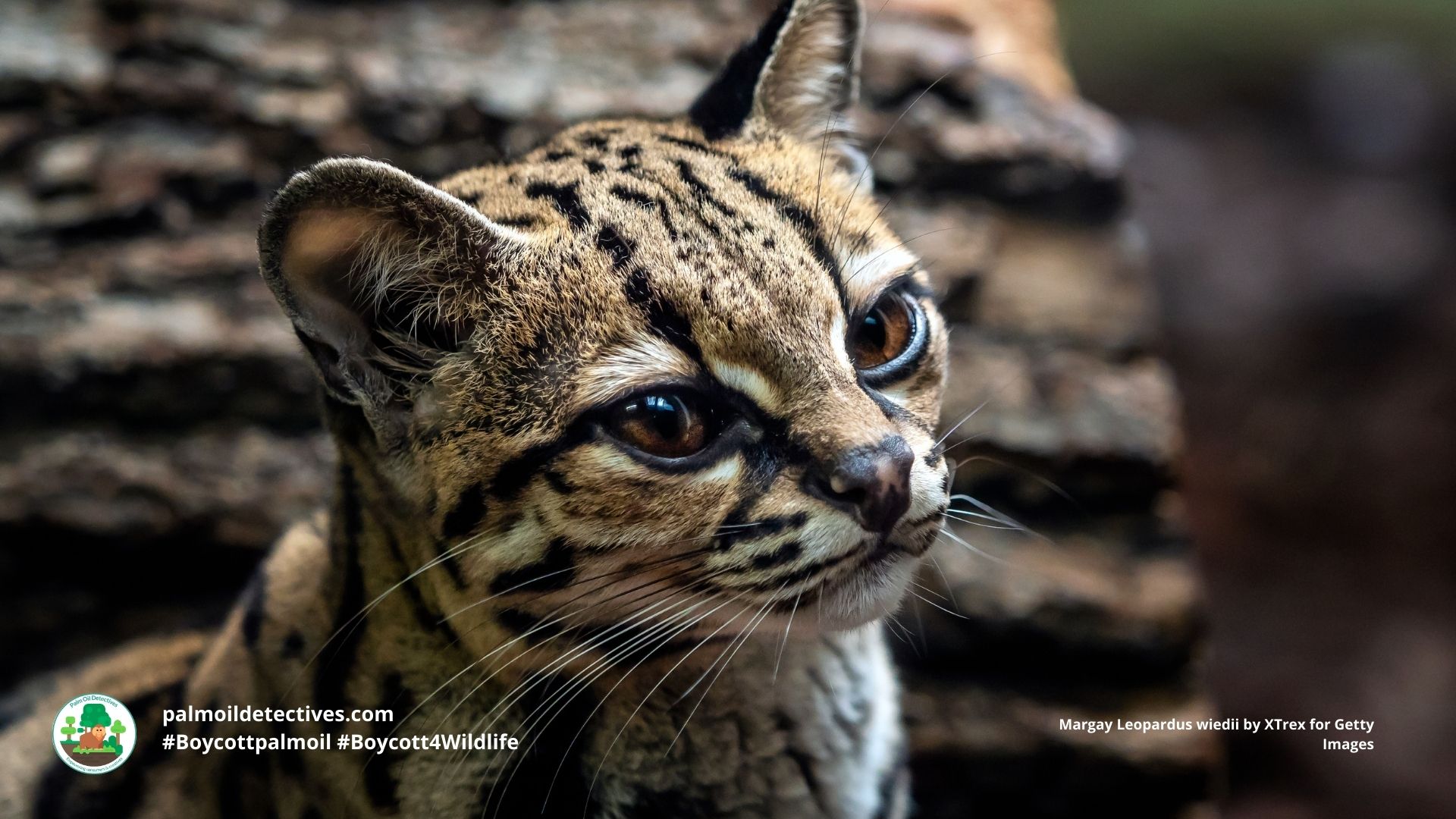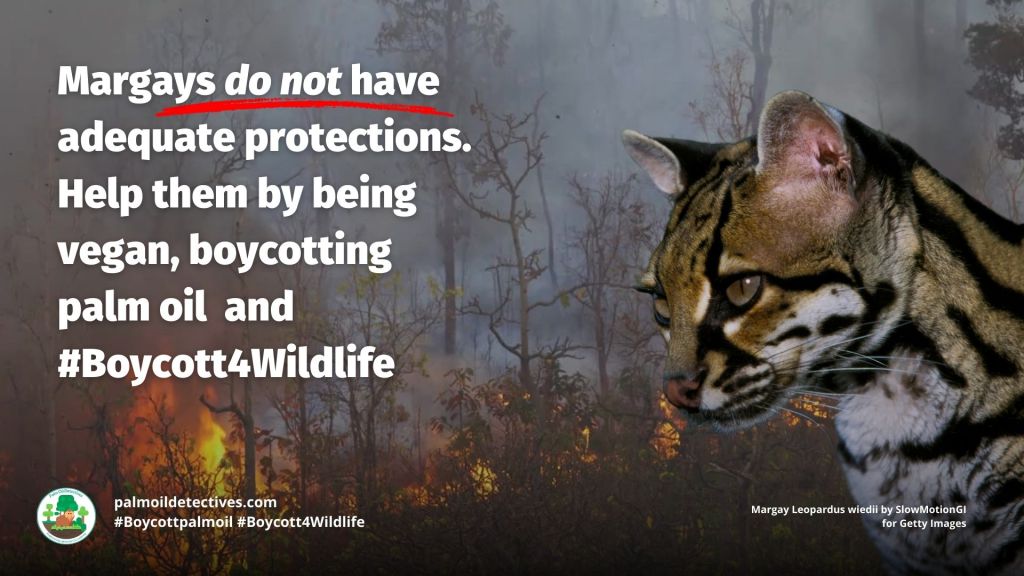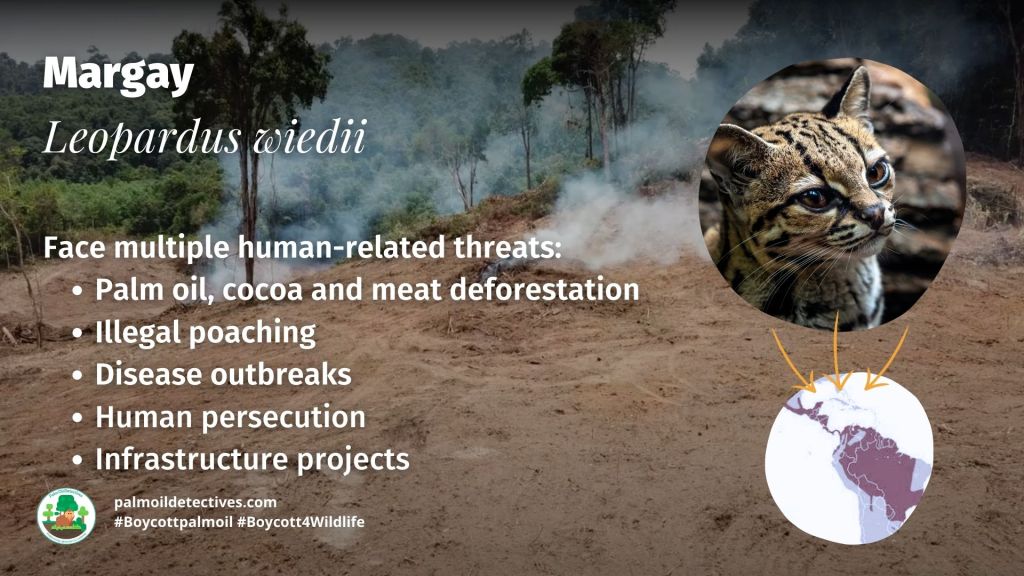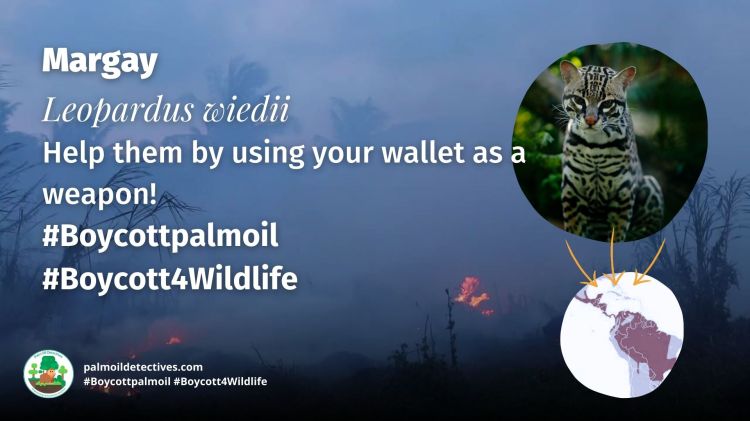Margay Leopardus wiedii
Near Threatened
Extant (resident)
Argentina; Belize; Bolivia, Plurinational States of; Brazil; Colombia; Costa Rica; Ecuador; El Salvador; French Guiana; Guatemala; Guyana; Honduras; Mexico; Nicaragua; Panama; Paraguay; Peru; Suriname; Uruguay; Venezuela.
Presence Uncertain
United States
Graceful, athletic and beautiful feline of the Amazon jungle, margays are small wild cats endemic to South and Central America. Every margay has a unique spotted pattern on their coat. They depend heavily on the rainforest canopy for hunting small mammals, reptiles and amphibians and are thought to mimic the call of the pied tamarin in order to hunt for them. Deforestation for #palmoil, soy and meat along with illegal poaching are devastating to them. Help them every time you shop and be #vegan, #Boycottpalmoil #Boycott4Wildlife
The graceful and beautiful small #wildcat the #margay is now ‘Near Threatened’ by #hunting, #palmoil #soy #meat agriculture in #Mexico #Brazil #Venezuela #CostaRica #Colombia. Help them survive and #Boycottpalmoil #Boycott4Wildlife
Tweet
No #Margay has the same gorgeous pattern of spots. They are Near Threatened in #SouthAmerica for #palmoil #soy #meat #deforestation and illegal #poaching. Fight for them and be #vegan, #Boycottpalmoil #Boycott4Wildlife
Tweet
Appearance & Behaviour
They have black lines behind their ears and their skin is soft and thick. There is immense individuation in terms of their beautiful coat pattern. No two margays are exactly alike in their colouration and kittens are born with their spots.
The fur of a margay varies in colour from grey-brown to tawny, and russet yellow. They possess dark spots and open rosettes of dark fur akin to leopards.
There is no sexual dimorphism, with males and females having the same appearance and size.
Margays are agile climbers and are also known as the ‘tree ocelot’ for their grace and athletic abilities.
They can twist and turn their ankles 180 degrees and can grasp onto branches with their fore and hind paws and they use their long tails for balance.
These adaptations assist them in hunting birds and monkeys through the tree canopy. They are well adapted for living in dense rainforests. Research studies have found that their populations thrive in areas of thick jungle, with little human disturbance.
Their flexible ankles helps them to climb down from trees gracefully, head first. As is typical with many cat species, margays lay in wait to ambush prey.









Threats
Margays are becoming increasingly rare. They have the classification of ‘Near. Threatened’ on IUCN Red List. To date, their global population size has not been adequately measured by researchers. Thus, there could be far fewer of them left than estimated.
Margays face multiple human-related threats including:
- Palm oil, meat and soy deforestation: Populations have become heavily fragmented due to agricultural expansion and deforestation for palm oil, cattle ranching and soy.
- Illegal poaching: Margays have been heavily exploited and hunted for their fur for centuries. This illegal poaching and hunting still occurs in the domestic black market.
- Human persecution: Margays are shot in retaliation by farmers for eating their chickens.
- Disease outbreaks
- Infrastructure projects




Habitat
Margays live in northern Mexico, Central America, and in South America, east of the Andes mountains, and as far to the south as Uruguay and northern Argentina.
They thrive almost exclusively in heavily forested evergreen forest, tropical dry forest and alpine cloud forest. Rarely are they found outside of forested areas, such as in agricultural plantations for soy, coffee or cocoa.
They are mostly solitary and nocturnal. However, in southern parts of Brazil they have been seen actively hunting in the day time.
These cats make their nests in the hollows of trees and are considered to be more arboreal than other cat species. Margays do also travel and hunt while on the forest floor.
Like other cats, male margays mark their territory with urine and secretions and will keep their distance from one another or otherwise have aggressive confrontations when their territories overlap.
Diet
They are known to mimic the vocalisations of pied tamarins while hunting for them.
Margays are considered carnivores but will also eat vegetation to aid their digestion. Analysis of their diet has shown that they consume reptiles, birds’ eggs, small birds, small mammals such as monkeys, squirrels, guinea pigs and chickens, tree frogs, lizards and arthropods.
They are able to capture and consume their prey completely in the tree canopy but will also venture to the ground to hunt.
Mating and breeding
Margays form temporarily bonded pairs during mating and breeding season and the pair will sometimes even hunt together. Males leave before the kittens are born and don’t help to rear them.
Female margays remain in oestrus for 4-10 days every 32-36 days. During this time they call on males with a plaintive moaning call. Male margays respond with a trilling call and shaking their heads rapidly – a behaviour not seen in other cat species.
A pregnant female will give birth after 80 days gestation period. Each pregnancy typically results in a single kitten and very rarely – two are born. Kittens weigh between 85-170g. Similar to domestic cats – they open their eyes at two weeks old and begin to eat solid foods at 7-8 weeks old and are reported to live to 20 years old when kept in captivity.
Kittens have a 50% mortality rate and their low wild breeding rate combined with difficulties breeding them in captivity make increasing their population problematic.
Support Margays by going vegan and boycotting palm oil in the supermarket, it’s the #Boycott4Wildlife

Support the conservation of this species
This animal has no protections in place. Read about other forgotten species here. Create art to support this forgotten animal or raise awareness about them by sharing this post and using the #Boycottpalmoil #Boycott4Wildlife hashtags on social media. Also you can boycott palm oil in the supermarket.
Further Information
de Oliveira, T., Paviolo, A., Schipper, J., Bianchi, R., Payan, E. & Carvajal, S.V. 2015. Leopardus wiedii. The IUCN Red List of Threatened Species 2015: e.T11511A50654216. https://dx.doi.org/10.2305/IUCN.UK.2015-4.RLTS.T11511A50654216.en. Accessed on 23 February 2023.
Margay Wikipedia article – https://en.wikipedia.org/wiki/Margay
Margay Animalia.bio – https://animalia.bio/margay


How can I help the #Boycott4Wildlife?
Contribute in five ways
1. Join the #Boycott4Wildlife on social media and subscribe to stay in the loop: Share posts from this website to your own network on Twitter, Mastadon, Instagram, Facebook and Youtube using the hashtags #Boycottpalmoil #Boycott4Wildlife.
2. Contribute stories: Academics, conservationists, scientists, indigenous rights advocates and animal rights advocates working to expose the corruption of the palm oil industry or to save animals can contribute stories to the website.
3. Supermarket sleuthing: Next time you’re in the supermarket, take photos of products containing palm oil. Share these to social media along with the hashtags to call out the greenwashing and ecocide of the brands who use palm oil. You can also take photos of palm oil free products and congratulate brands when they go palm oil free.
4. Take to the streets: Get in touch with Palm Oil Detectives to find out more.
5. Donate: Make a one-off or monthly donation to Palm Oil Detectives as a way of saying thank you and to help pay for ongoing running costs of the website and social media campaigns. Donate here








Thanks dear friend for your support in getting the message out…I really appreciate it 🙂
LikeLike